Introduction
Needless to say, there has been significant growth in the usage of web-sites to gain information in the past few years. Consequently, there has also been an increase in the range of channels or media through which these websites are accessed. When we speak about the medium, we talk about the variety of devices (desktop and handheld), the different types of browsers that the users use to access these websites, etc.
From the user’s perspective, they want to adopt a perfect device-browser combination that would give them the most seamless surfing experience. However, from a developer’s perspective, when they build a website, they can not allow their biases towards a browser to affect their development process.
They need to build or code the website in such a way that it renders perfectly in all types of browsers and devices. This is where the problem lies for the developers. They just can’t go around fiddling with each different type of browser and their several versions all day long.
A report by StatCounter in 2020 suggests that the market share grabbed by the Chrome Browser is a whopping 64.6%. However, browsers such as safari and firefox also grab a considerable share of the market. A particular browser might be popular in one geographical area, but not in the other. Hence, developers must test their websites for all types of browsers before they deploy them for production.

What is cross-browser compatibility testing?
Cross-browser compatibility testing is the approach adopted by the QA team to test the browser’s overall effectiveness across all the popular browsers in the market. This allows them to ensure that the website is equally responsive across all types of browser-device combinations.
After performing a thorough cross-browser compatibility testing, they can rest assured that all the popular browsers render responsive components in their websites such as forms, images, text paragraphs, etc. efficiently. Having discussed what cross-browser testing is, let’s now skim through a few reasons why is it necessary?
Why should we adopt cross-browser compatibility testing?
Each and every website must be tested for cross-browser compatibility before they are turned live into production. Let’s consider a scenario. Suppose you are a website developer and you have used all sorts of techniques such as media queries in CSS, etc. to make sure that your website is well responsive.
Now, you just need to ask a simple question? How do you know that your website will be responsive in all the other browsers as well? You have tested your website might be in your favorite Chrome or Firefox browser and a couple of devices such as your mobile phone and laptop. Or you might have used different screen sizes through inspect elements or any other tool. But the question still remains the same.
There are tons of browsers available in the market, each of them has multiple versions and different standards. There might be some HTML features that you have used in your website and works well in some browsers, but might not render in others. For instance, the WebM media format is not supported by Safari. IE and Edge don’t support the placeholder component in HTML. There are tons of similar examples.
Hence, it’s of utmost importance that you run or test your browsers in the most popular browsers and their versions. You might be thinking that this is insane. How can we test a website in all the browsers simultaneously because it’s practically impossible? Well, let’s clear this out as well.
The Problem with Cross-browser Compatibility Testing
As discussed above, there are a plethora of different browsers and versions each with different standards. So how do we test our website in all these browsers? Well, if we think about performing manual cross-browser testing for our website, then you might end up scratching your heads just a short while after you start.
However, there are a number of online tools that you can use to carry out automated cross-browser testing for all your websites on multiple browser-OS combinations.
These online tools will provide you with the comfort of testing websites on multiple browsers and devices available on-demand, hosted on the cloud. They allow you to test how your websites will look exactly on different browsers. There are multiple benefits of using an automated cross-browser compatibility testing tool. They allow you to choose from thousands of on-demand browser-OS combinations, pinpoint bugs, generate comprehensive reports, integrate CI/CD tools, etc.
Predominantly, we can categorize these tools into two high-level sets. The first set of tools allow you to simply simulate your websites in different conditions such as browsers, devices, etc. The second set of tools are those that allow you to create test cases and test steps, record UI Identifiers, and perform tests on specific UI components or parts of the websites, and generate environment-specific test reports. One such tool is Testsigma which we will discuss later on in this article.
If you have a website with a huge amount of traffic and you want it to be highly scalable, you must consider the second set of tools that allow you to perform in-sprint testing of feature-specific components. But before selecting any tool, make sure you know about all the features that a tool offers to you so that you don’t end up spending on tools that don’t cater to your requirements.
What features should cross-browser compatibility testing tools have?
Let’s discuss a few features that you must look out for in any automated cross-browser compatibility testing tool.
1. The tool must let you test on all the widely used browser-OS configurations and most importantly, allow you to test on multiple combinations simultaneously i.e. in parallel.
2. It should allow you to create test cases or steps for feature-specific components. For example, if you want to check the compatibility only for the signup or login UI component, it should allow you to create test-suites specific to this feature.
3. The tool must be able to integrate with the development or testing workflow. There are certain tools like Jenkins, Puppet, Chef, etc. that are an essential part of the development workflow. The tool must be able to integrate with such Continuous Integration and Monitoring tools so that your sprints are not affected.
4. It should allow you to increase the test coverage, especially when your website starts gaining traction. Some methods to increase test coverage are testing for positive as well as negative workflows, parallel cross-browser testing, testing of large suites, testing on multiple test environments, etc.
5. It should allow you to go for complete automation. In other words, it should require minimal manual intervention right from setting up the tool, understanding the different features of the tool, etc.
6. It should be time-efficient, meaning it should allow you to execute repeated test cases without having to specify them again and again.
7. You should be able to test pages that require authentication, i.e., those pages that can be accessed only after signup or login.
8. It should be able to generate comprehensive, environment-specific test reports. By this, we mean that you should be able to see individual test reports for all the types of browser-OS configurations that you have performed your tests on. It should also provide screenshots or video recordings of the entire process of testing.
9. It should support team collaboration. You should be able to share bug-reports with your team, work with them to resolve the bugs, and document them.
10. The most important one is that the tool should have efficient customer support that will be available for you 24×7 to assist you through multiple channels such as chat, phone, email, etc.
Why should you use Testsigma as your cross-browser compatibility testing tool?
Testsigma is one such power-packed tool that you should not miss out on if you want to perform cross-browser compatibility testing, especially on complex websites. Testsigma sits right on top of the deck when it comes to automated cross-browser testing tools. It’s a scriptless test automation tool, meaning you can create test cases for UI testing on multiple browser environments using simple natural language. You don’t even need to have prior experience in creating complicated Selenium scripts or programming in general.
Testsigma simplifies the entire process of cross-browser compatibility testing by managing multiple browser-OS configurations on the cloud so that you can have access to them on-demand. You can test your website for multiple UI components simultaneously on 1000+ real browser-device combinations using parallel execution of test cases. It allows you to zero-in on the amount of manual intervention required to perform the test executions.
The entire process is quite simple and intuitive. It allows you to record UI identifiers on your websites automatically and you can use them to create test steps and test cases. After that, you can use these test cases to create feature-specific test suites on which you will be performing the tests.
After that, you can create test environments where you will have the option to select the type of browser, device, OS, and test (cross-browser, parallel, customized). That’s it! You can now just run the tests and get a drill-down comprehensive report to analyze.
It frees you from the hassles of licensing, installation or setup, configurations, etc. Everything is simple with Testsigma.
Some features of the Testsigma tool that makes it one of the best cross-browser compatibility testing tools are –
1. You have immediate access to 1000+ real browsers and devices that are hosted on the cloud.
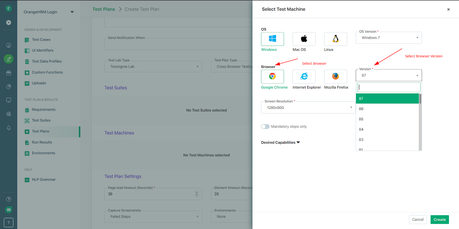
2. You can integrate the testsigma tool directly into your development pipeline. After you pull out the commits from Git to your pipeline created by Jenkins, you can integrate it with the testsigma tool directly to carry out tests on those features within the sprint.
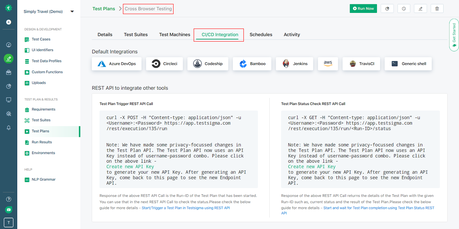
3. You can easily increase your test coverage by executing complex test suites simultaneously using parallel cross-browser testing. This will significantly reduce the testing time and let you focus on other important aspects of development.
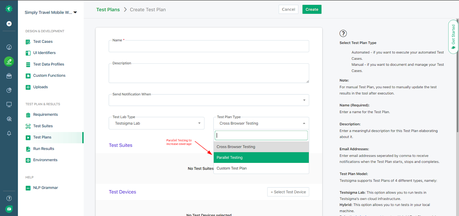
4. It allows you to record UI Identifiers automatically so that you can use them in your test cases to perform cross-browser tests on specific UI components only instead of performing repeated tests on all features.
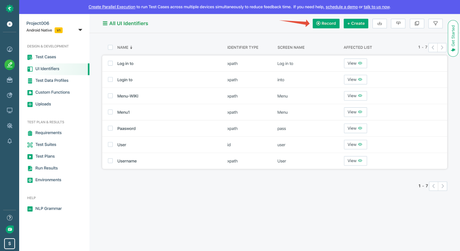
5. You can easily create test cases using simple natural language. In fact, it has the autocomplete feature as well which will automatically complete your test step based on the initials that you provide. For example, if you want to create a test step to tap on a login button, just start writing “Ta..” and it will show you a list of steps that you can perform
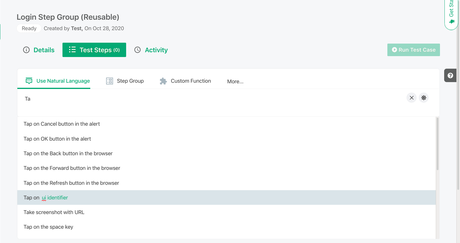
6. It allows you to collaborate with your team and report bugs, share test results, identify solutions, and fix them, all in a single unified platform.
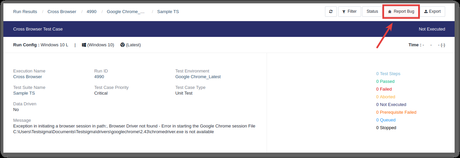
7. You can easily generate comprehensive, customizable, environment-specific reports along with screenshots and recordings of the entire test flow. This allows you to identify the root cause of bugs or failures and work on solutions to fix them. It has in-depth filtering methods and even allows you to export the test results.
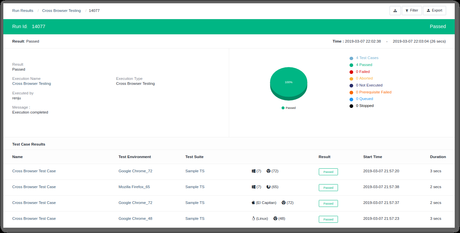
Wrapping Up!
When it comes to testing your websites, you must ensure that you carry out all aspects of testing so that bugs won’t creep out when users are surfing your websites. Performing cross-browser compatibility testing is a hectic task. But with the use of the right approach and tools, it becomes a piece-of-cake.
Instead of carrying out testing processes manually, it’s always beneficial if you think of other automated alternatives to save your valuable time, effort, and resources.
Bottom line, when selecting a tool that you want to adopt for a long-term perspective, you might want to make sure that it caters to all your present and future requirements. You might be satisfied currently with most tools that are available online that allow you to simulate your websites on multiple browsers and viewports.
However, finding the one right tool that will stay with you even when your website has gained a lot of traction and you want to scale it is worth the effort.
Testsigma is one such automated cross-browser testing tool that is suitable for both small-scale websites as well as highly-complex large websites. It is easy-to-use and requires no installation so that you can get started right away. With tons of support and features, you might not want to miss out on such a power-packed tool.
Get the free trial of Testsigma and see it for yourself.

